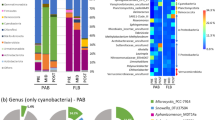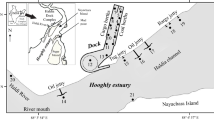Abstract
Episodic river flash floods, characteristic of Mediterranean climates, are suspected to greatly affect the functioning of microbial food webs. For the first time, the abundance, biomass and diversities of microbial food web components were studied before and during 4 consecutive days after a flash flood that occurred in November 2008, in the surface waters of five stations along a salinity gradient from 20 to 36 in the Thau lagoon. Eukaryotic pico- and nanophytoplankton were discharged from the river into the lagoon and increased by 30- and 70-fold, respectively. Bacteria increased by only 2-fold in the lagoon, from around 4–8 × 106 cells ml−1, probably benefiting from river nutrient input. Chlorophyll a increased 4-fold, and pigment biomarkers showed that the dinophyceae, prasinophyceae and prymnesiophyceae were sensitive to the flood perturbation, whereas the bacillariophyceae, cryptophyceae and chlorophyceae were resistant and/or transported to the lagoon from the river. Predator responses were more complex as total heterotrophic flagellate abundance decreased slightly, whereas those of specific naked ciliates increased, particularly for Uronema sp. The flood also induced a specific change in diversity, from a community dominated by Strobilidium spiralis to a community dominated by Uronema sp. The tintinnid community was particularly sensitive to the flood event as the abundance of all species decreased greatly. The high increases in biomass, mainly brought by the river during the flood, could have eventually sedimented to the benthic layer and/or been transported further into the lagoon, supporting the pelagic food web, or have even been exported to the Mediterranean Sea.





Similar content being viewed by others
References
Bec, B., J. Husseini-Ratrema, Y. Collos, P. Souchu & A. Vaquer, 2005. Phytoplankton seasonal dynamics in a Mediterranean coastal lagoon: emphasis on the picoeukaryote community. Journal of Plankton Research 27: 881–894.
Cognetti, G. & F. Maltagliati, 2000. Biodiversity and adaptive mechanisms in brackish water fauna. Marine Pollution Bulletin 40: 7–14.
Costanza, R., 1999. The ecological, economic, and social importance of the oceans. Ecological Economics 31: 199–213.
Crise, A., J. I. Allen, J. Baretta, G. Crispi, R. Mosetti & C. Solidoro, 1999. The Mediterranean pelagic ecosystem response to physical forcing. Progress in Oceanography 44: 219–243.
Cushing, D. H., 1990. Plankton production and year-class strength in fish population: an update of the match/mismatch hypothesis. Advance Marine Biology 26: 250–293.
Descy, J. P., 1993. Ecology of the phytoplankton of the river Moselle – effects of disturbances on community structure and diversity. Hydrobiologia 249: 111–116.
Dupuy, C., A. Vaquer, T. Lam-Höai, C. Rougier, N. Mazouni, J. Lautier, Y. Collos & S. Le Gall, 2000. Feeding rate of the oyster Crassostrea gigas in a natural planktonic community of the Mediterranean Thau Lagoon. Marine Ecology Progress Series 205: 171–184.
Gasol, J. M., U. L. Zweifel, F. Peters, J. A. Fuhrman & A. Hagstrom, 1999. Significance of size and nucleic acid content heterogeneity as measured by flow cytometry in natural planktonic bacteria. Applied & Environmental Microbiology 65: 4475–4483.
Gasol, J. M., M. Comerma, J. C. Garci, J. Armengol, E. O. Casamayor, P. Kojecka & K. Simek, 2002. A transplant experiment to identify the factors controlling bacterial abundance, activity, production and community composition in a eutrophic canyon-shaped reservoir. Limnology & Oceanography 47: 62–77.
Lebaron, P., P. Servais, H. Agogué, C. Courties & F. Joux, 2001. Does the high nucleic acid content of individual bacterial cells allow us to discriminate between active cells and inactive cells in aquatic system? Applied Environmental Microbiology 67: 1775–1782.
Lionard, M., K. Muylaert, D. V. Gansbeke & W. Vyverman, 2005. Influence of changes in salinity and light intensity on growth of phytoplankton communities from the Schelde river and estuary (Belgium/The Netherlands). Hydrobiologia 540: 105–115.
Ludwig, W., P. Serrat, L. Cesmat & J. Garcia-Esteves, 2004. Evaluating the impact of the recent temperature increase on the hydrology of the Têt River (Southern France). Journal of Hydrobiology 289: 204–221.
Milly, P. C. D., R. T. Wetherald, K. A. Dunne & T. L. Delworth, 2002. Increasing risk of great floods in a changing climate. Nature 415: 514–517.
Muylaert, K. & W. Vyverman, 2006. Impact of a flood event on the planktonic food web of the Schelde estuary (Belgium) in spring 1998. Hydrobiologia 559: 385–394.
Muylaert, K., J. Van Wichelen, K. Sabbe & W. Vyverman, 2001. Effects of freshets on phytoplankton dynamics in a freshwater tidal estuary (Schelde, Belgium). Archiv fr Hydrobiologie 150: 269–288.
Nixon, S. W., 1982. Nutrients, primary production, and fisheries yields in coastal lagoons. Oceanologica Acta 5: 357–371.
Perrin, J. & M. G. Tournoud, 2009. Hydrological processes controlling flow generation in a small Mediterranean catchment under karstic influence. Hydrological Sciences Journal/Journal des Sciences Hydrologiques 54: 1125–1140.
Plus, M., I. La Jeunesse, F. Bouraoui, J. M. Zaldivar, A. Chapelle & P. Lazure, 2006. Modelling water discharges and nitrogen inputs into a Mediterranean lagoon – impact on the primary production. Ecological Modelling 193: 69–89.
Pomeroy, L. R. & W. J. Wiebe, 1988. Energetics of microbial food webs. Hydrobiologia 159: 7–18.
Sherr, E. B., D. A. Caron & B. F. Sherr, 1993. Staining of heterotrophic protists for visualization via epifluorescence microscopy. In Kemp, P. F., B. Sherr, E. Sherr & J. J. Cole (eds), Handbook of methods in aquatic microbial ecology. Lewis Publishers, Boca Raton, FL: 213–229.
Taguchi, S. & E. A. Laws, 1989. Biomass and compositional characteristics of Kaneohe Bay phytoplankton inferred from regression analysis. Pacific Science 43: 316–331.
Ter Braak, C. J. F., 1988a. CANOCO – a FORTRAN program for canonical community ordination by (partial) (detrended) (canonical) correspondence analysis, principal components analysis and redundancy analysis (version 2.1). Technical report LWA-88-02. Agricultural Mathematics Group, Wageningen.
Ter Braak, C. J. F., 1988b. Partial canonical correspondence analysis. In Bock, H. H. (ed.), Classification and Related Methods of Data Analysis. North-Holland, Amsterdam: 551–558.
Treguer, P. & P. Le Corre, 1975. Manuel d’analyse des sels nutritifs dans l’eau de mer: Utilisation de l’Autoanalyzer II Technicon, 2nd ed. Laboratoire d’Oceanographie chimique Univ. de Bretagne Occidentale. (Textbook of Nutrient Analysis in Marine Water: Utilization of the Technicon Autoanalyzer II).
Troussellier, M. & J. M. Deslous-Paoli, 2003. Thau lagoon: a working site for the acquisition, integration and valorization of lagoon ecosystem knowledges. Oceanis 27: 257–289.
Vaquer, A., M. Troussellier, C. Courties & B. Bibent, 1996. Standing stock and dynamics of picophytoplankton in the Thau Lagoon (northwest Mediterranean coast). Limnology and Oceanography 41: 1821–1828.
Vidussi, F., J. C. Marty & J. Chiaverini, 2000. Phytoplankton pigments during the transition from spring bloom to oligotrophy in the northwestern Mediterranean Sea. Deep Sea Research 47: 423–445.
Vidussi, F., B. Mostajir, E. Fouilland, E. Le Floc’h, J. Nouguier, C. Roques, P. Got, D. Thibault-Botha, T. Bouvier & M. Troussellier, 2011. Effects of experimental warming and increased ultraviolet B radiation on the Mediterranean plankton food web. Limnology and Oceanography 56: 206–218.
Wang, Y., F. Hammes, N. Boon, M. Chami & T. Egli, 2009. Isolation and characterization of low nucleic acid (LNA)-content bacteria. The ISME Journal 3: 889–902.
Webber, D. F., M. K. Webber & J. C. Roff, 1992. Effects of flood waters on the planktonic community of the Hellshire coast, Southeast Jamaica. Biotropica 24: 362–374.
White, P. A., J. Kalff, J. B. Rasmussen & J. M. Gasol, 1991. The effect of temperature and algal biomass on bacterial production and specific growth rate in freshwater and marine habitats. Microbial Ecology 21: 99–118.
Zapata, M., F. Rodríguez & J. L. Garrido, 2000. Separation of chlorophylls and carotenoids from marine phytoplankton: a new HPLC method using a reversed phase C8 column and pyridine-containing mobile phases. Marine Ecology Progress Series 195: 29–45.
Zubkov, M. V., B. M. Fuchs, S. D. Archer, R. P. Kiene, R. Amann & P. H. Burkill, 2001a. Linking the composition of bacterioplankton to rapid turnover of dissolved dimethylsulphoniopropionate in an algal bloom in the North Sea. Environmental Microbiology 3: 304–311.
Zubkov, M. V., B. M. Fuchs, P. H. Burkill & R. Amann, 2001b. Comparison of cellular and biomass specific activities of dominant bacterioplankton groups in stratified waters of the Celtic Sea. Applied Environmental Microbiology 67: 5210–5218.
Acknowledgments
We thank Captain Michel Cantou for field assistance, Jean Nouguier for the continuous monitoring technical development, Aurore Trottet for help in sampling and Romain Pete for help with statistical analyses. David Pecqueur was supported by a national scientific PhD fellowship provided by the French Ministry of Education and Research. This study is part of the project ‘Impact des eaux de crue sur le réseau microbien de la lagune de Thau (RESTHAU)’ funded by the ‘ECosphère Continentale et Côtière’ (EC2CO) French National Program.
Author information
Authors and Affiliations
Corresponding author
Additional information
Handling editor: Sigrún Huld Jónasdóttir
Rights and permissions
About this article
Cite this article
Pecqueur, D., Vidussi, F., Fouilland, E. et al. Dynamics of microbial planktonic food web components during a river flash flood in a Mediterranean coastal lagoon. Hydrobiologia 673, 13–27 (2011). https://doi.org/10.1007/s10750-011-0745-x
Received:
Revised:
Accepted:
Published:
Issue Date:
DOI: https://doi.org/10.1007/s10750-011-0745-x




